Past Exhibitions
2024 Exhibitions
Josh Deweese / Chris Autio
"Old Friends - New Work in Clay and Photography"
November 15 - December 15
Josh DeWeese Artist Statement
This exhibit with my friend Chris Autio presented the opportunity for something new. Having done some experimentation with our local Bear Canyon earthenware, I decided to invest the time in making a full kiln load of work with the material to see what could happen. The pots in this show are made with a mix of Montana earthenwares from Bear Canyon, east of Bozeman and M2, a clay site east of Lewistown. The pots are decorated with slips, terra sigillata and minimal glazes, and fired in my wood kiln. I am excited by the results and look forward to sharing them.
Josh DeWeese is a Professor of Art teaching ceramics at Montana State University in Bozeman where he is currently serving as the Director of the School of Art. From 1993-2006 DeWeese served as Resident Director of the Archie Bray Foundation for the Ceramic Arts in Helena, Montana and he holds an MFA from the New York State College of Ceramics at Alfred, and a BFA from the Kansas City Art Institute. He is the co-founder of the International Wild Clay Research Project at Montana State University, promoting the use of local materials and sustainable practices in the ceramic arts. In 2022 DeWeese received a Montana Governor’s Award in the Arts. He has exhibited and taught workshops internationally, and his work is included in numerous public and private collections.
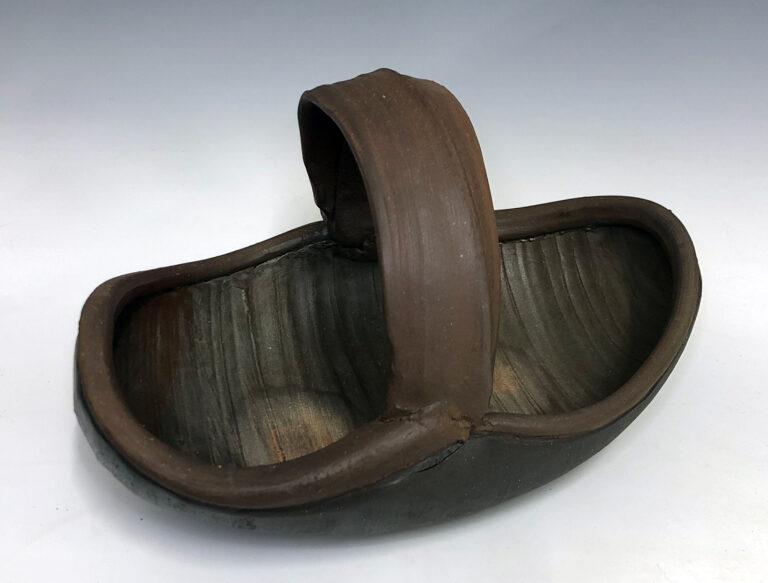

Chris Autio Artist Statement
After arriving in Mexico, I immediately began photographing everything Mexican: colored balloons, tacos served at night, food plates, paper-mache skeletons. This is par for the course when traveling. But I soon developed a different eye for different material.
I enjoy a certain satisfaction figuring out how to travel in another country. Finding the small collectivo taxis, paying with new money, speaking in broken Spanish. I wandered small villages, forgotten corners. Photographing junk. Signs from the last decade: the same forlorn stuff around the world, I suppose. I began composing photographs within the city, thinking in terms of value and texture, edifices being a common backdrop.
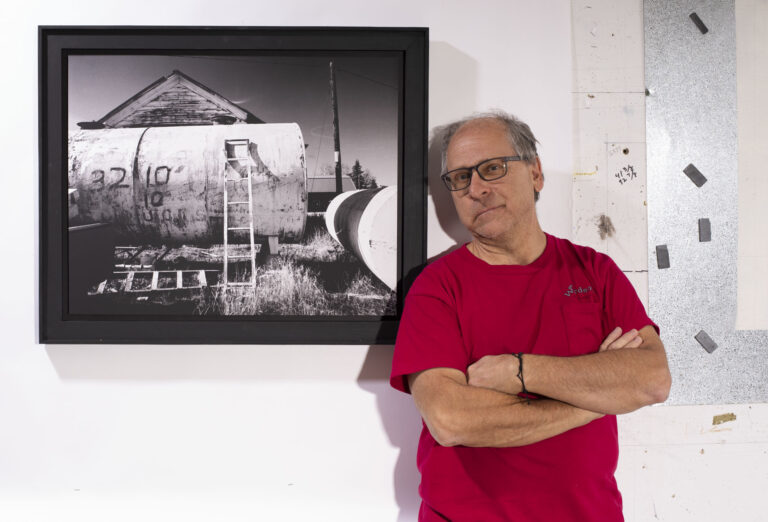
Selisa Rausch
October 11 - November 10
Selisa Rausch
Artist’s Statement
Observational drawing is at the center of my artistic practice. Although I care deeply
about environmental, political, and cultural issues, my work doesn’t originate with a
concept. It begins with my eye, hand, and intuition. Something visually interesting will attract my eye and, through the meditative act of drawing, I search for the subject’s aesthetic and expressive potential. The practice of life drawing also plays a vital role.
Having drawn the figure for over 30 years, I “see” through the lens of the human form, where even inanimate objects become anthropomorphized as I respond to their implied postures, gestures, and personalities.
I began drawing chairs in graduate school (perhaps as a stand-in for the human figure). Initially attracted to the vertical and horizontal bones of a chair’s construction, I liked how the object naturally divided the picture plane into pleasing proportions. When raised on a platform “face to face” and drawn at large scale, the chair evoked a strong, sentient presence. It was looking directly at me which fostered an introspective drawing experience. It’s my hope that the viewer feels a similar sense of engagement.
The chair (or group of chairs) provides plenty of visual and psychological dualities to play with: interior/exterior, overstuffed 3D form/2D flat upholstery pattern, stability or rigidity/playfulness, movement, etc. A chair with wheels has the potential to move yet remains fixed in its two-dimensional pictorial space. High contrast shadows not only create additional shapes, but also heighten drama. Often I’ll take cues from the material a chair is made from when choosing a medium, technique, or substrate. In this way, the materials themselves can help evoke the memory of an era, enhance mood or personality, rather than my relying on details of context or resorting to literal anthropomorphic depictions. Less meditative than working from an object or still life, the act of life drawing is more immediate and demands confidence. Currently working with the female nude, I’m not interested in idealized or seductive female poses, nor is academic virtuosity or imitation my main goal. Again, I thrive on the tension between three dimensional figuration and two dimensional compositional structure while also hoping to capture the mood of the pose. The searching marks that remain are evidence of my working quickly to find the principal geometry rather than named forms like “arms, legs, face”. I use both additive and subtractive techniques as I wipe down (suppress) and pull forward (reveal) various parts of the image. The resulting marks can be expressive in addition to descriptive. This process of seeing and the search for an aesthetic awareness far outweigh the end product. They are where the Art lies and what brings me the greatest sense of artistic satisfaction.
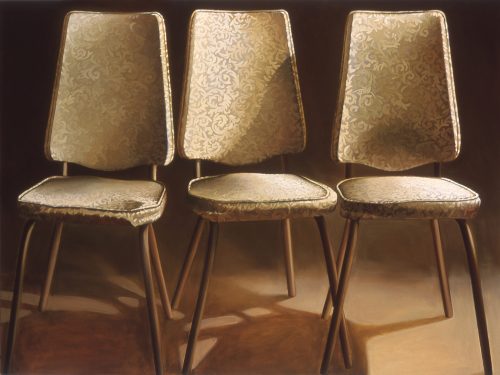
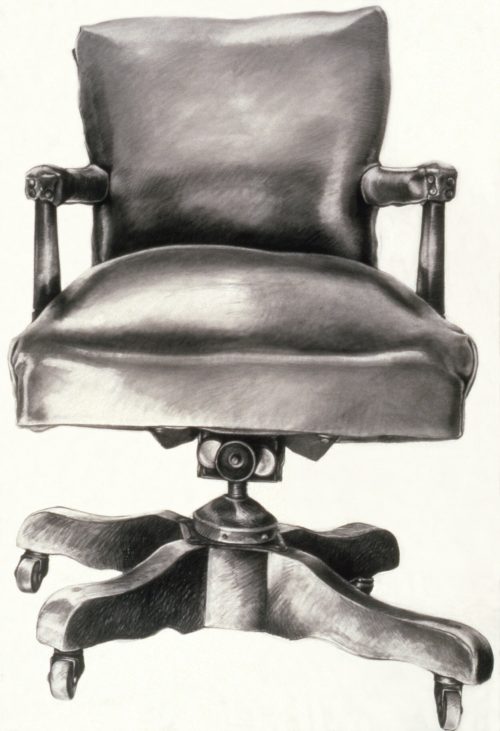
Eva Isaksen and Solveig Landa
Artists In Residency
September 20 - September 29
Eva Isaksen's Work
Eva Isaksen’s life and work is hard to disentangle from nature. She grew up north of the Arctic Circle in Norway, later lived among the mountains and meadows of Montana; and eventually settled in Seattle, where her love of growing things bloomed along with her art. “One becomes an extension of the other” she says about her gardening and artwork. Her studio overlooks the garden where she grows vegetables and a large variety of flowers. As she works, she often moves between the spaces, finding reprieve in rotating the abstract world of her art with the very tangible realm of flora.
Isaksen works with collages and monotype prints, often combining the two to create multilayered pieces. There is an element of the unexpected in both mediums that attracts her. With monotypes, the printed image is reversed from what she assembles on the plate which creates surprises. And because she uses transparent papers in her collages, hues shifts and forms change as she layers. Isaksen predominantly paints or prints on thin Nepali papers, but some of her more recent pieces also include vintage Norwegian magazine clippings from her grandfather’s bookstore, as well as table linens from her mother, connecting the present with her past. She collects images and inspiration from nature and the landscapes that she visits.
Her work has its own narrative, it shows glimpses of history and memory, but ultimately it is about color, form, space and abstraction. It is also about a place where the intuitive becomes one with the experience collected from a lifetime as a working artist.


About Solveig Landa´s Artwork
Solveig Landa works with printmaking and three-dimensional works. She is interested in topics that deal with the interaction between humans and nature and the consequences of our presence in the world.
Connections, memories, circuits, energy and existence are consistent motifs. At the same time, she wonder about conditions in nature and how we use them in rituals and myths. In her work Landa is inspired by and curious about manufactured structures and man-made constructions that surround us, but always with nature as the main inspiration. Many of the projects are about taking care of things, recycling, processing and finding new ways to use seemingly banal objects. In this process, the original object loses its function and enters a new context, which also acquires an important function and power. Through an almost poetic approach, she builds up a simple and abstract idiom, where human conditions, unfair distribution of resources and concern over environmental issues come to light. In all of this lies a belief that the environment affects us, and by including it in her art she finds possible entrances to an expanded understanding of our species and being in the world.
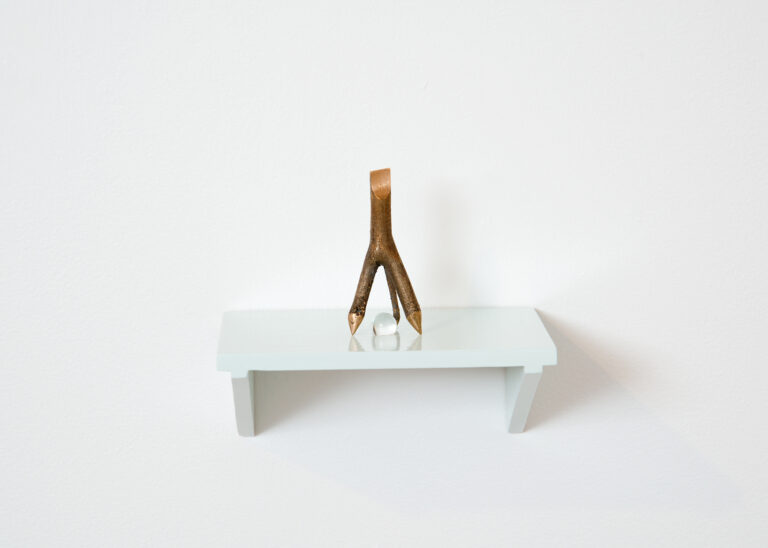
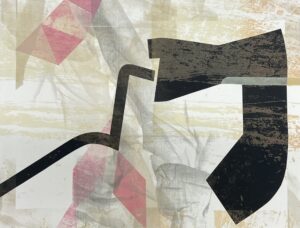
Melba Price and Bruce Tapola
August 24 - September 1
Special Show for the Dofe House Residents, Melba Price and Bruce Tapola. Opening, Saturday, August 24th (4:30 to 7:30 PM) Please note that the Opening is on a Saturday, not the usual Friday.
Short Stories is a collection of 200 (or so) small collaborative works on paper by Melba Price
and Bruce Tapola.
As well as pursuing our own studio practices we have worked in collaboration, in some fashion, with each other and with artist friends since 1978. This project began casually in May of 2020 on our back porch by passing these paintings back and forth and trying to entertain each other with our wit, skills, wisdom or lack there of. As the individual drawings piled up, basic themes started to emerge (romance, sci-fi, western, history) which then became complicated by our
artistic agreements and disagreements, by our mis-interpretation of content, and by our supporting or undermining (to humorous effect) the other one’s content/context/vibe. The finished pieces are like tiny parts of larger stories, both integral and insignificant.
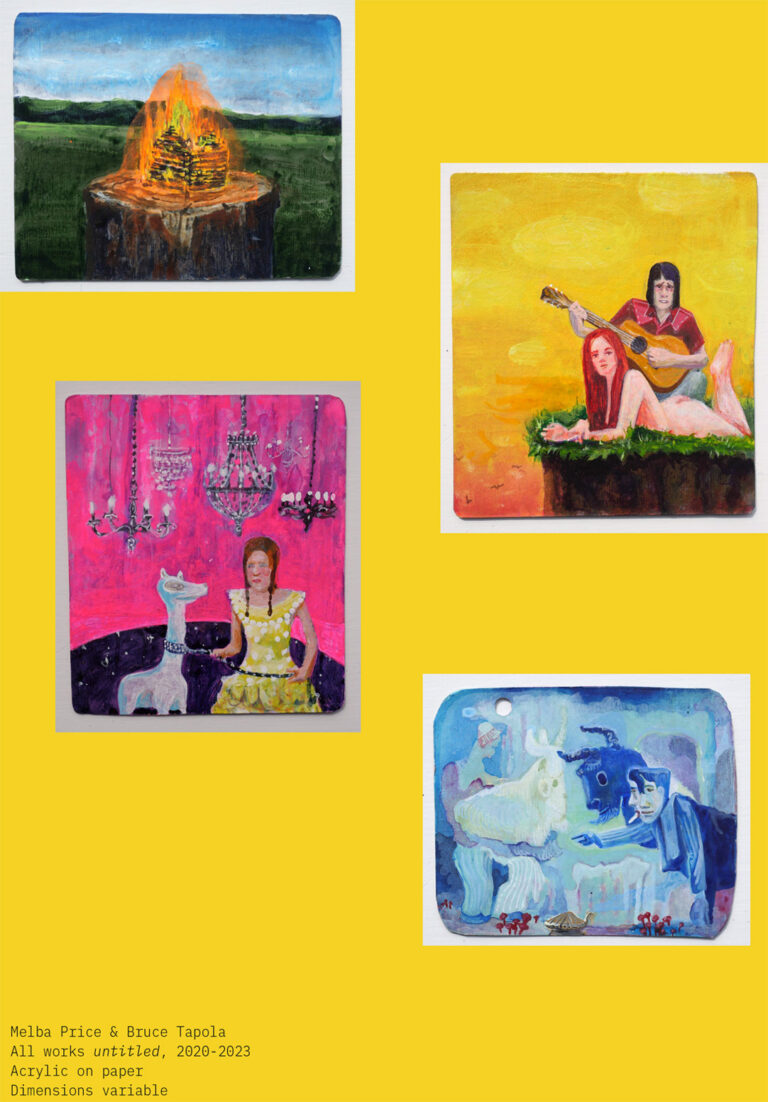
Melba Price Biography
Melba Price was born in Texas and raised in Utah. She received her BFA from the University of Utah in Salt Lake City and her MFA from Montana State University in Bozeman, MT. She has exhibited nationally and has been the recipient of several grants and fellowships including, The Arts Midwest National Endowment for the Arts Visual Arts Fellowship,
the Mcknight Foundation Fellowship, the Minnesota State Arts Board Fellowship and a Minnesota State Arts Board Career Opportunity Grant. She has twice received the Bush Foundation Fellowship – Visual Art (1994,2002). Melba’s works is included in many
public and private collections and written about in Artforum, New American Paintings ,and Startribune, She currently lives and works in St Paul, MN
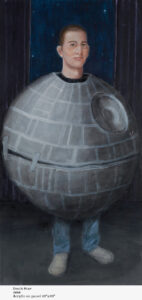

Bruce Tapola Biography
Bruce Tapola was born and raised in Ohio. He received his BFA from the University of Utah in Salt Lake City and his MFA from Montana State University in Bozeman, MT (1983). He has exhibited nationally and internationally and has been the recipient of several awards including the McKnight Foundation Visual Artist Fellowship (2017, 2001, 1995).
His work has been written about in Artforum, The New York Times, New American Painting, Artpapers, Startribune, New Art Examiner, and more. He taught painting and drawing at St. Cloud State University (MN) from 2000 to 2022. In addition to his own studio practice Bruce is a member of the artist collectives, Paintallica, Free Art School, Rat Trap Clay Club (RIP) and Artpolice. Bruce lives and works in St. Paul, Minnesota.


Jim Madden and Cindy Owings
July 19 - August 18
Jim Madden – Biographical Statement
After fifteen years of practicing architecture in Portland, Oregon, Jim Madden moved to Montana in 1988 and began painting. Madden returned to school in 1992 to study painting at the School of the Art Institute of Chicago and the University of Iowa. Returning to Bozeman after graduate school, Madden continued work as a studio painter. In 2006 he started to do public art commissions in the region. From 2015- 2024, Madden has worked with Mountain Time Arts, producing public artworks that inspire and deepen connections to this place.
Madden’s work has been exhibited in museums and galleries, including the University of Iowa Art Museum, the Missoula Art Museum, the Museum of the Rockies, and the Paris Gibson Museum in Great Falls. Madden’s paintings have been published in the Iowa Review and his drawings are included in a critical survey of contemporary drawing, Drawing Now, published by Loughsborough University in 2007.
Willem Volkersz
June 14 - July 14, 2024
Willem Volkersz
Willem Volkersz was born in Amsterdam, the Netherlands and emigrated to Seattle with his family when he was 14. He received a BA in painting from the University of Washington and an MFA from Mills College in 1967. He taught for 18 years at the Kansas City Art Institute and 16 years at Montana State University in Bozeman where he was also Director of the School of Art.
The artist’s work has been included in exhibitions in the US, Canada, Great Britain, Japan, China and Taiwan and is included in the collections of the Portland Art Museum, Yellowstone Art Museum, Missoula Art Museum, the Booth Western Art Museum, the Whitney Western Art Museum, the Museum of Neon Art, and the National Holocaust Museum in Amsterdam,
the Netherlands.
Corporate and institutional collections include Montana State University, the Dairy Block (Denver), the Watertown Hotel (Seattle),
the Armory Hotel (Bozeman) and hospitals in Kansas City and Iowa City.
The artist is a collector fascinated with American popular culture of the mid-20th century. Objects (especially travel souvenirs) collected in second hand stores often augment his narrative sculptures. The artist has also extensively documented environments built by folk and outsider artists and he draws inspiration from these artists’ ingenuity and use of found materials.
The artist and his wife live in Bozeman, Montana.
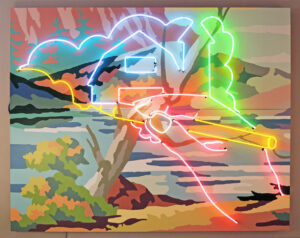
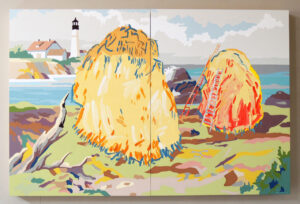
Brandon Reintjes and Alison Reintjes
May 10 – June 9, 2024
Alison Reintjes
I’m a Montana artist making geometric wall sculptures and functional objects. I am committed to non-representational, shape-based abstraction and have maintained a studio practice for over 20 years.
I studied glass blowing at Kent State University and the Canberra School of Art before graduating from Northern Michigan University. I moved to Montana in 2001 for a residency at the Archie Bray Foundation for Ceramic Art in Helena. I am grateful to have Montana as my home and artistic community.
In addition to my studio practice, I have taught art in public schools, led workshops, and exhibited and lectured at universities, art centers, and museums. I have had solo exhibitions at the Missoula Art Museum and the Holter Museum of Art, completed public art commissions, and received the 2017 Montana Arts Council Artists Innovation Award.

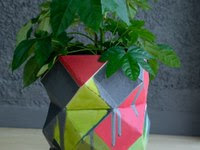
Brandon Reintjes
Brandon Reintjes was born in Bozeman, Montana and grew up in Northern Michigan. He received a BFA in fine arts from the School of the Art Institute of Chicago and an MA in curatorial and critical studies from the University of Louisville. He works as senior curator at the Missoula Art Museum and spends the majority of his time thinking about, looking at, and making art. He has exhibited at the Zootown Arts Community Center and the Brink Gallery in Missoula, MT; Luminary Arts Center in St. Louis, MO, the 930 in Louisville, KY, Turman Larison Contemporary in Helena, Aunt Dofe’s Hall of Recent Memory in Willow Creek, MT. He has completed an Artist·Forest·Community, residency in the Helena National Forest in 2001, Myrna Loy Center for the Performing Arts residency in Helena in 2004; and most recently an OpenAIR residency at America Prairie Reserve in 2023.

2023 Exhibitions
G A L E A R V A N I T E S
M U S E
Noun: to be absorbed in thought
Verb: a source of inspiration
ARTIST’S STATEMENT
A work of art is not performed by the artist alone,
it is the viewer that completes it.
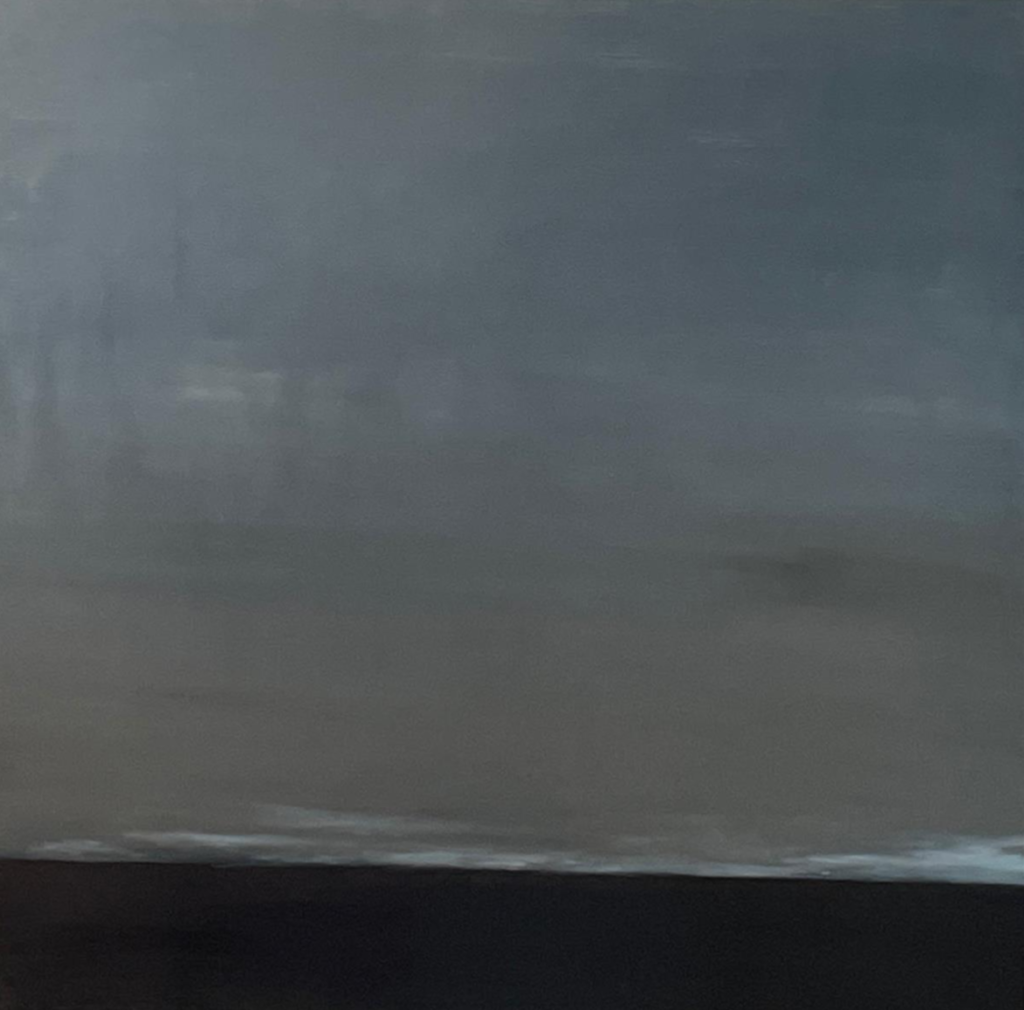
PAINTINGS
Every painting has a life of its own.
I grow each painting layer upon layer of a multitude of colors and various mediums.
Upon completion, it is almost as if the work becomes alive,
transforming as the viewer moves to the left right, forward and backward,
as well as when the light of day shifts.
“The mission of art, to make us pause and look at a thing a second time.”
Oscar Wilde
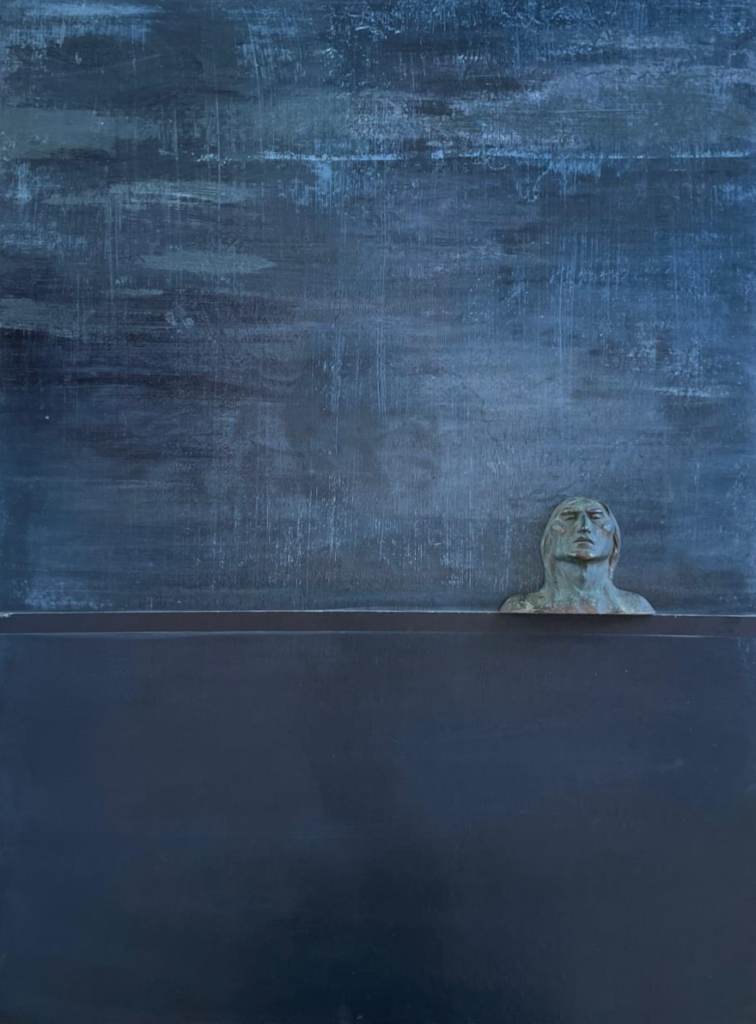
SCULPTURES
I am a conceptual sculpture, encouraging thought and conversation.
They can be interpreted in many ways, there is no right or wrong,
“I wanted to restore art to the service of the mind.” – Marcel Duchamp
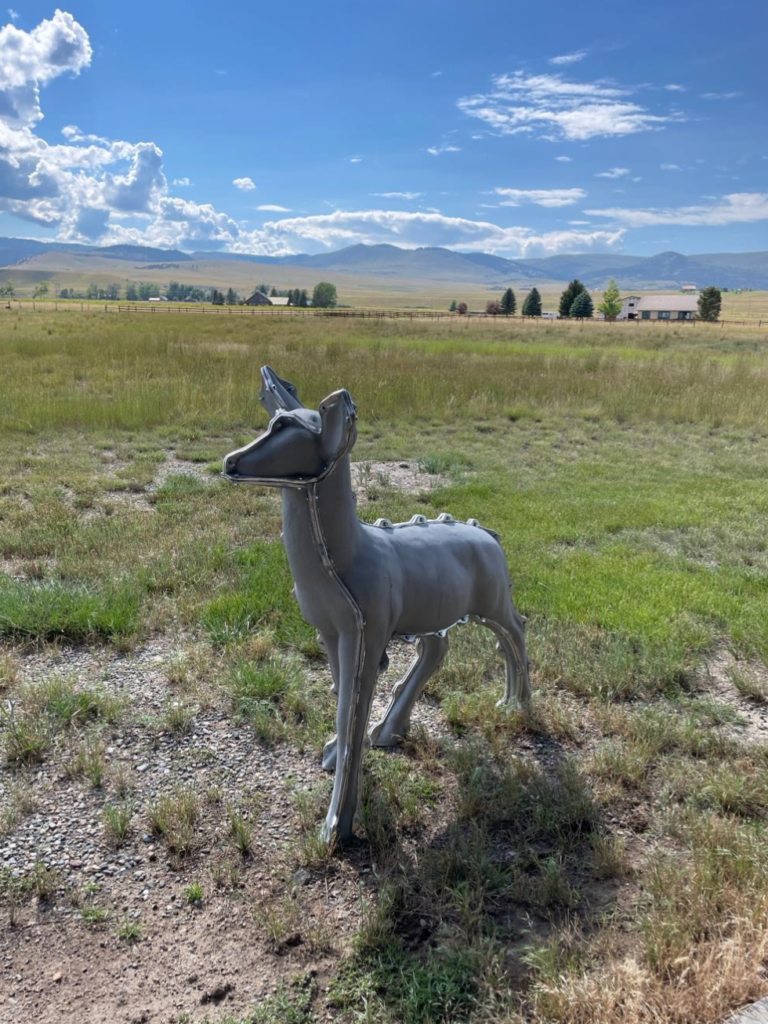
Michael Haykin
July 21st – August 20th, 2023
 Biography
Biography
Michael Haykin was born in 1954 and raised in Munich, Germany, while his father was in the military service for the United States. He holds a Bachelor of Fine Arts from the University of Virginia in Charlottesville. His lifetime of extensive travel influences his work.
In addition to regular solo and two-person shows at galleries, Haykin’s work has been exhibited at the Holter Museum of Art in Helena, Montana, and the Yellow-
stone Art Museum in Billings, Montana. He has been represented by Helander Gallery in Palm Beach, Florida; Works Gallery in Southampton, New York; Limbo
Gallery in New York City; and Holly Solomon Gallery in New York City.
“Michael Haykin is one of the most refreshing and compelling realist painters working today. Whether it’s in his heroic scaled multi-paneled compositions, or his smaller easel-sized paintings, Michael’s veiled atmospheric perspective creates a mosaic of form and color—elevating the artist’s portraits and everyday scenes of landscapes into a surreal, dreamlike world of soft personal expression.Haykin’s aesthetic is perfectly matched to his ambition as a painter of the West, and I’ve observed that his canvases appeal to lovers of contemporary abstraction
as well as those whose inclinations tilt toward traditional realism. On the surface the work appears to be straightforward and representational, but on closer exam-
ination one finds the paintings filled with images drawn from explorations of the artist’s internal narrative and personal mythology. I am very excited that Michael
has relocated from Key West to Tucson and will be adding his enormous talents to the collective artistic genius of our region.” – Robert E. Knight, Executive Director, Tucson Museum of Art
ARTIST’S STATEMENT
“I am a painter whose interest in observing the changing moment provides the structure for my work. While my paintings are composed with formal consider-
ations, the focus is on the changing nature of my subject matter. The surface of my paintings is built of micro-layers of pigment allowing light and atmosphere to
subtly shift, giving the image a shimmering translucency.”
Jennifer Combe / Matthew Hamon
June 16th – July 10th, 2023
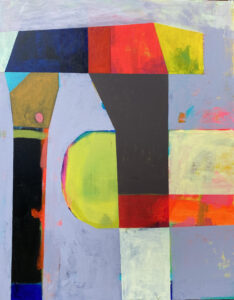
Jennifer Combe
Biography
Jennifer Combe is a mother, artist, and associate professor of art at The University of Montana. Before shifting to higher education, she taught K12 in Washington State public schools for fifteen years.
Her artwork investigates gender, contemporary mothering, and children’s development. Her visual work has been exhibited at The Missoula Art Museum, Holter Museum of Art, The Gift Shop exhibition space at The Henry Art Gallery in Seattle, The NAEA gallery in Virginia, and The Washington State Center for Performing Arts. Her work is featured in the book An Artist and a Mother, published by Demeter Press. Her work in art education spans early childhood education, community arts, and social theory. Her educational work has been featured in The Journal of Social Theory in Art Education, The Journal of the Motherhood Initiative for Research and Community Involvement, The Journal of Cultural Research in Art Education, and Visual Arts Research.
She has lectured for The National Art Education Association in New York, Chicago, San Diego, Dallas/Fort Worth and New Orleans. She lectured on mothering and art education in Florence, Italy for The Motherhood Initiative on Research and Community Involvement.
She lives outside of Missoula, MT with her family. More of her work can be found at www.jennifercombe.com.
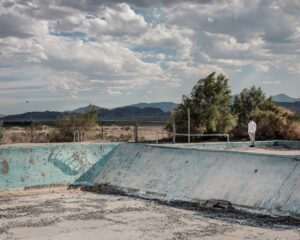 Matthew Hamon, Bio:
Matthew Hamon, Bio:
Matthew Hamon is a freelance portrait photographer based in Montana. His photography exists conceptually and aesthetically in the liminal spaces between photojournalism and staged editorial imagery.
Matthew hails from a small, remote town in Northern California. A sense of place informed by wandering the woods as a child inspires his enquiry.
Self-described as “post-rural,” Matthew currently lives in Missoula, Montana near the Blackfoot River. Matt is a featured artist in Scott Ligon’s, “Digital Art Revolution,” ( Watson-Guptil/Random House). Matthew’s work has been featured in CNN, The New York Times, Outside Magazine, The Independent -UK, Lens Culture, LifeFramer, 1 Million Photographers (1MP), 6Mois.fr, Stern.de, XL Semanal, Le Monde, morphyne.com, Edge of Humanity, Don’t Take Pictures, Month of Photography, Los Angeles (MOPLA), PDN’s Emerging Photographer, and Smith Journal. Matthew was a finalist for the 2016 edition of “Nera di Verzasca Award,” winner of the Diaframmi Chiusi Photography Prize, and IPHA 5 (Manifest’s International Photography Annual). He is a 2016 Syngenta photography award recipient and first prize winner in PhotogrVphy’s 2016 grant. Matthew was awarded first prize in the 2018 Portraits Hellerau exhibition in Hellerau, Germany. He was featured in the 2016 and 2017 editions of the Taylor Wessing Portrait Prize at the National Portrait Gallery, London, UK, and in The Royal Photographic Society’s International Photography Exhibition 160 (IPE 160). More of his work can be found at www.matthewhamon.com.
Phoebe Toland/Linda Stoudt
May 12 – June 11, 2023
2022 Exhibitions
Christine Joy/Sara Mast
October 21- November 27, 2022
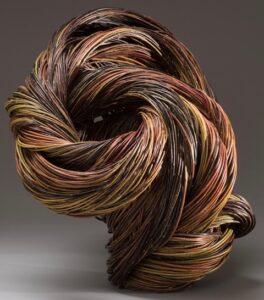 Christine Joy
Christine Joy
Christine Joy was born in Ithaca, New York in 1952. She graduated from Rochester Institute of Technology in 1976 with a B.F.A. in Printmaking. In 1980 after completing a master’s program in art therapy at Vermont College she moved west. She now lives in Bozeman with her husband who helps her collect willow every fall.
christinejoywillow.com
 Sara Mast
Sara Mast
Mast received her MFA from Queens College in New York. Her work is in over thirty corporate, private and museum collections worldwide and is featured in several publications that include: Encaustic Painting: Contemporary Expression in the Ancient Medium of Pigmented Wax (Watson-Guptill, NY, 2001), Art & Science Now, (Thames & Hudson, NY, 2010), Encaustic Art in the 21st Century (Schiffer Publishing, PA, 2016) and Launching the Imagination (McGraw Hill, NY, 2017). Mast is a drawing and painting professor in the School of Art at Montana State University. She lives and works in Bozeman, Montana.
saramast.com
Kathryn Schmidt/Jennifer Pulchinski
September 16 – October 16, 2022
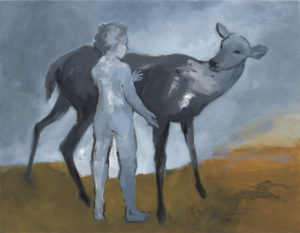 Kathryn Schmidt
Kathryn Schmidt
“As a poet I hold the most archaic values on earth. They go back to the Neolithic: the fertility of the soil, the magic of animals, the power-vision in solitude, the terrifying initiation and rebirth, the love and ecstasy of the dance, the common work of the tribe.” Gary Snyder
I am the descendant of German engineers and Irish farmers so it should not be surprising that I like to make things, first sculptures and then paintings. Though I came of age during the abstract and minimalist years, my work is figurative and narrative. Maybe my 1950’s/60’s Catholic childhood played a part with its reel of otherworldliness running alongside the everyday aspects of one’s life. What a rich mix it was – the visuals, Latin masses, the music, heroic saints, heaven and hell!
I am still interested in the mysteries of the world, the ultimate things and am always looking for the delivering image. My almost 40 years in Montana’s powerful landscape has had an impact, but more than rendering physical description, I use the landscape as an arena for psychological and emotional takes on the world. Even I don’t exactly know how the combinations of things come about in my paintings but the best ones have an air of inevitability about them.
There are many “travel” pieces, travel representing any kind of exploration – new locations, new ideas – and now my concerns are climate change and our fraught relationship to the natural world. And the many deer paintings? I sometimes joke that I have a deer for every occasion but they are versatile – existing both just outside our windows and in high remote places – so they easily play a variety of roles. And the figures are nudes so that we can more easily insert ourselves in the painting, imagining essential interactions with the birds or animals.
That is my focus: we humans learning to see the wildlife around us and the earth beneath our feet that so sustains us. We Americans especially have a lot to learn. And not much time.
Kathryn W Schmidt
July 2022
kathrynwschmidt.com
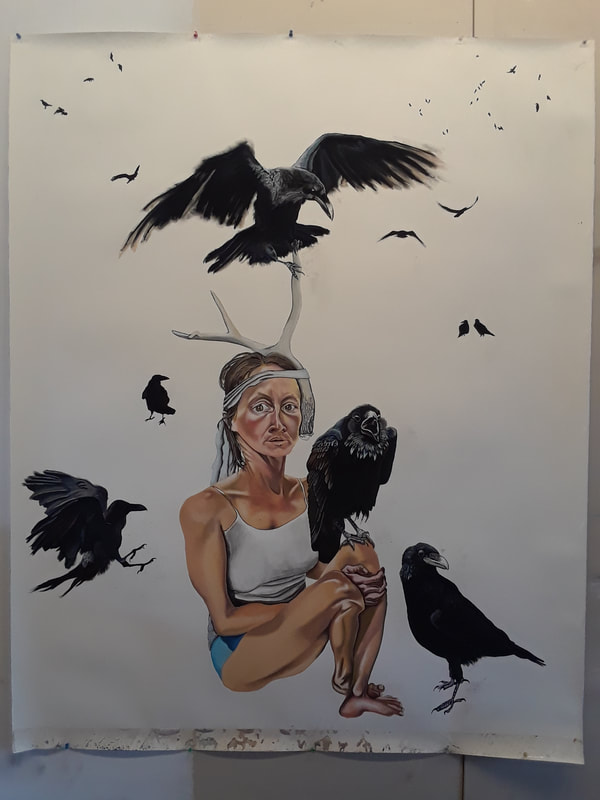 Jennifer Pulchinski
Jennifer Pulchinski
Jennifer Pulchinski was born in Wisconsin 1977. Her professional education started with buisness and psychology in Wisconsin. In 2000 she moved to Montana to work in Yellowstone National Park, at Mammoth Hotspring. She continued with her education in 2001 at Montana State University, Bozeman. Her focus was education, finishing with her Bachelor of Fine Arts and was awarded the Bronze Pencil in 2008 from MSU Bozeman. Pulchinski still resides in Bozeman where she continues her professional career as a sculptress and drawer.
jenpulchinskiportraits.weebly.com
Kim Cheselka
August 5 – September 9, 2022
 Kim Cheselka
Kim Cheselka
By channeling the innate practice of gathering, observing and exploring, visual artist Kim Cheselka creates compelling narratives.
Through this process, in painting, sculptural work and installations, identifiable and often common objects become elements in her personal iconography.
Cheselka’s work entices the viewer to delve not only into her unique visual expression but their own process of investigation as well.
Her current projects include large scale gouache paintings focused on the symbolic nature of tree growth rings, as well as site specific installations incorporating willow charcoal, rocks and hand coiled steel springs.
Artist Statement
Trees, rocks, and charcoal I am older now. I look at objects, and life, differently. Spending time in nature has always been essential for me.
This need only continues to grow stronger with the passing years. I carry nature back to my studio where I explore the cross-sections of trees. Focusing on the growth rings takes me on a journey that’s an acknowledgment of the past, a meditation on the then and now.
In a similar action, I like to walk rivers. Searching for willow and rocks; discovering the beauty of their shapes and colors. The transformation of willow to charcoal is ancient, and powerful. Building a fire, heating the willow, turning the wood into energy.
Time is transformation.
This is where I live.
Kim Cheselka
kimcheselka.com
Jerry Iverson – “New work: art is boxes and Windows”
June 24 – July 30, 2022
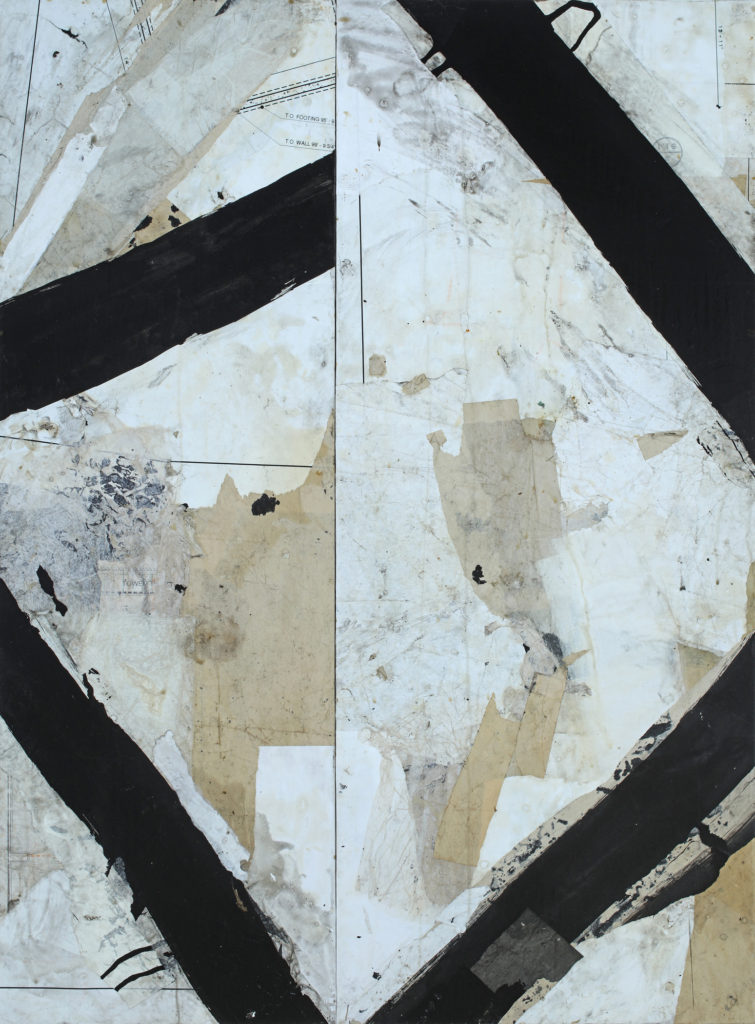 Iverson Bio
Iverson Bio
I was born in 1951 and raised on farm in South Dakota. In 1974, I received a degree in philosophy from St.Olaf College in Minnesota. While in college, I spent summers working on a ranch near Big Timber, Montana. After graduation, I moved to the Big Timber area and learned how to shear sheep and pack horses.
Inspired by the dramatic beauty of the natural landscape, and the harsh isolation of the social and political landscape, I started to make art. I was curious and intrigued by both figurative representation and abstraction, and I tried different materials and techniques to capture and tell the story of my life. The traditional route of entering juried shows and sending images to galleries led to opportunities for showing my art in Montana and in cities around the US. Art has allowed me a fascinating blend of rural and urban life.
Iverson Artist Statement – 2022
I understand my art as having two parts: How it looks and What it means.
How it looks is a description of the materials, colors, texture, forms, balance, composition – the formal elements. I’ve done many colorful, figurative oil paintings and many mixed media abstractions. For the last 20+ years, my materials have mainly been Sumi ink, paper and rabbit skin glue on board. I use a brush to make black lines on various kinds of paper, soak the paper in rabbit skin glue, then put layers on board – adding brushstrokes of ink as I go. The resulting work is a bold composition of black lines on a white background, with shades of gold, brown and gray. The many layers create a rough and dense texture, with previous lines showing through the translucent paper from deep beneath the surface.
What it means is much more obscure, personal and is determined by the emotions and ideas that I try to express to the viewer. That’s what I love about making art – it comes from deep inside and reflects the story of my life. My art has been much influenced by the beauty, balance and grace of Asian calligraphy. I often work in a series of pieces around a central idea expressed over and over again. Each idea has a look and meaning of its own.
jerryiverson.com
Crista Ann Ames
April 1 – May 1, 2022
Crista Ann Ames is a sculptor working primarily in ceramics wood and textiles. Through the layering of mythology, iconography and personal narrative, Crista explores how our own animal nature relates to the ways we establish and sustain personal relationships. Raised on a small hobby farm in Washington State, Crista often draws on her own experiences to explore pastoral life, animal husbandry, women’s craft and fertility. Visit her website here.
Rollin Beamish / Jim Zimpel: “Kindred By Choice”
Jan. 22 – March 6, 2022
Jim Zimpel
Zimpel’s work constructs factual and imaginary entry points and rituals-they are the means to process, explore and understand things that are actually, or perceived as, inaccessible. A meaningful fishing experience, a trip to a natural wonder, a project built together in the garage shop behind the house. His practice is an attempt to attend to actual and desired familial bonds. It is location, object, or activity. A fire ring, a broken engine, a hug, the forced proximity between two men dictated by the hull of a 14’ fishing boat. It is recollection and recognition, an interpretation of traditions, fiction and history; an exploration of the terms of patrilineal relationships as he understand them.
Rollin Beamish
Rollin Beamish was born and raised in Ohio, where he also pursued his formative studies. His recent work is inherently fragmentary and appropriationist, becoming much more loosely allegorical when installed in aggregate. Conceptually, a broad rubric of concern over ‘media literacy’ has provided its strongest motivation, particularly the factors that contribute to the symbolic efficacy of so-called ‘late-capitalist’ consumer society (especially in the US). The tensions in the work are suggestive of the artist’s belief that an incommensurable gap, or non-relation, effectively undergirds meaning, regardless of what appears to be its “object cause”. This in turn reflects his commensurate commitment, through his work, to an unfixed and processual perspective on interpretation and action. Beamish lives and works in Bozeman, where he is an Associate Professor of Painting and Drawing at Montana State University, while he also maintains a studio and part-time residence in Berlin, Germany.
2021 Exhibitions
Kathleen Rabel
Sept. 24 – Oct. 30, 2021
Kathleen Rabel’s painting, sculpture, and prints are shown internationally and throughout the United States. She is Professor Emerita of Cornish College of the Arts where she was Head of Prints and Works on Paper. She received a Teaching Excellence Award from the students at Cornish and was awarded a “Nelly” from Cornish alumni for excellence in teaching.
OF NOTE
• Portugal: Rabel was awarded a Fulbright Senior Scholars grant and created iron sculpture using traditional Portuguese methods documented in Recent Sculpture: A Portuguese Voice.
• Contemporary Print Artists of Paris exhibition: by invitation one of twenty-five exhibiting artists representing the United States.
• Abbey of San Vincenzo in southern Italy (1997—2016), artist-in-residence.
• +=studio blu=+, Seattle’s experimental workshop: Co-founder and artist-in- residence focused on art on paper and emerging artists (1996—2019).
EXHIBITIONS
International: Switzerland, Yugoslavia, Japan, China, Korea, Portugal, Italy, Israel, Russia, France, Mexico, and Canada.
National: Museum of Modern Art, Brooklyn Museum, Walker Art Center, Rhode Island School of Design, Carnegie Institute, Seattle Art Museum, Tacoma Art Museum, and The Henry Gallery at the University of Washington.
SELECTED COLLECTIONS
• The British Museum Collection of 20th Century Prints and Drawings
• Bibliotheque Nationale de France archives: Publication, Kathleen Rabel: Selected Prints
• The Museum of Modern Art, New York, The Collection of the Vatican, Abbazia di San Vincenzo al Volturno, The Brooklyn Museum, Shenzhen University and Hubei Institute of Art, China, Seattle Art Museum, The Portland Art Museum, Tacoma Art Museum, Microsoft, and the Cities of Seattle; Kobe, Japan; and Beersheba, Israel.
EDUCATION
B.A., Painting, M.F.A., Print Art, University of Washington.
Jerry Rankin/Joop de Meij
Aug. 20 – Sept. 19, 2021
Jerry Rankin
Artist Statement
As a Montana artist I continue to share my exploration of the allegorical landscape in its various dimensional perceptions: its oscillations and horizons, its chromatic and tectonic shifts, and the analogy between sound and geographic space.
Biography
I was born in 1934, raised in Montana, and graduated from Montana State and the University of Montana (MFA) with degrees in painting and printmaking. My careers have included teaching, associate professor, graphic artist and professional artist. My work is in permanent collections at YAM, MAM, Museum of ART and Culture and Viterbo College in Wisconsin. I’ve been awarded two Montana Art Gallery Director (MAGDA) grants for traveling exhibits and a 30 year retrospective at the University of Montana. Examples of my work can be seen at my website: rankinart.com.
Joop de Meij
Standing on my toes, I gazed into the deep bubbling pot of sausage and potatoes my mother was cooking while I listened to family stories. So many of their conversations centered around their scarring war experience in Holland right before I was born.
These frightening stories knotted up in my stomach while fueling my imagination. Fortunately, I had an understanding father, an artist and a teacher, who brought me to museums and showed me ways of seeing through my uncomfortable world.
Life was filled with smells too strong, images too vivid and classes too dull. At 19 years old, I entered an experimental art school, Ateliers 63, in Haarlem Holland. Everyone’s imagination was alive with a sense of exploration. It was here, while painting, that I met my first wife, who came from Bear Canyon, Montana via Minneapolis School of Art.
Immigrating to Montana was a wild experience in the 1970’s. The Vietnam war was hanging over us and my draft number was close to being called. I was threatened with a sheep shear haircut by those angry at my long hair, while at the same time I found a vibrant community of artists to work with.
Bear Canyon gave me room to explore without pressure. Meeting Jerry Rankin was a gift. Together we appreciated the safety that nature offered and shared the complexities of isolation and creativity that the canyon offered us. We absorbed the beauty, raged at the darkness, and knew we were not alone.
Finding free chunks of cottonwood right outside my door changed my direction from painting to sculpture. Wood has remained my art medium and my companion, as I live surrounded by thousands of trees.
Sometimes it takes me years to finish a piece. I put components of non-working artwork aside until a better idea comes to me. Then I reconfigure, change colors, or add an item until it is complete. Often, I end up with a sculpture that is completely different from the original idea. A puzzle must be present in order for me to stay interested in the piece.
Images of pipes, combs and fruit come into my artwork through influences of Magritte’s artwork and childhood memories. Added to these are the current conditions of climate change and the reappearance of fascism, demanding my response.
The golden pipe hints at a gift of sharing, a sacred cow, and a sensual opening. An asteroid next to a bar of soap describes time. The arrogance of Hitler’s hat becomes a crown of stolen life. The feminine form of a large pear painted black is a mother that can no longer feed us.
I am surrounded by the seductive belief that change is impossible: too difficult to attempt. Is transformation possible, or are we again approaching a Last Supper?
For more information I can be reached at joop.demeij@gmail.com
Paintallica
July 30 – Aug. 6, 2021
Paintallica was formed in 2004 by a group of graduate students at the University of Iowa who joined together in the effort to engage in a more vigorous approach to art-making and criticism. Beginning with brutally honest critiques and all night drinking and art-making sessions, Paintallica has evolved into a large group of artist friends who strive to create provocatively authentic art through collaboration.
Our installations are improvised and largely site-specific. We begin our process gathered around a table making drawings and passing them back and forth to initiate a collaborative dialogue. Additionally, we take field trips to explore unique aspects of the local culture. Out of these activities ideas emerge that are then transformed into our
installations.
We approach each new space as an arena where criticism is carried out through action and the work is built from a brutal processes of creation, destruction, and rejuvenation. We often work in public and our interaction with the audience (and at times audience participation) are important elements that contribute to Paintallica’s rowdy carnival atmosphere. Our ultimate goal is to create engaging art that gains its strength from
powerful imagery and monumental shifts in scale. Our installations are not unlike a changing small town where things are built, used and eventually abandoned before being re-imagined as something that can be used again.
This process of creation and destruction whether in art or development leaves hints of a vibrant and complicated past that can never be fully understood but whose presence is essential. Our creative interventions are in many ways an encapsulation of this inevitable process of change in which old is relentlessly replaced by new, except rather than resisting it we choose to embrace it and strive for better and more meaningful deaths and rebirths.
2019 Exhibitions
Jay Schmidt
Nov. 22 – Dec. 31, 2019
Biography:
Jay Schmidt was born in Chester, Pennsylvania, and studied at the Kansas City Art Institute where he became influenced by regional folk art and the imagists of the Hairy Who in Chicago and the California Funk Movement. He then headed to the University of California, Davis where he received an MFA in 1976. Schmidt then moved to Iowa City to teach in the art department at the University of Iowa.
In 1983 Schmidt joined the faculty of the Montana State University’s School of Art in Bozeman, Montana, where he taught for 26 years retiring in 2009. Since the 70’s, he has created a diversified body of work consisting of drawings, paintings and sculptures that address issues of contemporary consumerist culture, politics and the environment. In the last ten years Schmidt has been an active participant in a number of collaborative art groups including Paintallica, the Free Art School and the Rat Trap Clay Club. He continues to reside in Bozeman, Montana.
Click here to Jay’s website
Phoebe Knapp
Oct. 4 – Nov. 15, 2019
Biography:
Phoebe Knapp, a graduate of the Rhode Island School of Design, is a third generation rancher on the Crow Reservation near Fort Smith, Montana. She has exhibited widely in the western states and her work is collected throughout the United States. Solo exhibits include: Missoula Art Museum, Art Park, Yellowstone Art Museum, Rocky Mountain College, Visions West- Bozeman, and Walker Fine Arts, Denver. Group exhibits include: Collective Design Fair, NYC; Bozeman Sculpture Park; Nicolaysen Museum, WY; Montana State University-Billings; Boise State University; and La Napoule Art Foundation, Denver. Knapp divides her time between Fort Smith and Billings, where she has a studio in the historic district.
Click here to Phoebe’s website
Sandra Dal Poggetto
August 16 – September 27, 2019
Biography:
Selected solo exhibitions: Montana Museum of Art & Culture, University of Montana, Northwest Museum of Arts & Culture, Yellowstone Art Museum, Oregon State University, University of California at Davis, Peter Koch Printers; Group Shows include: Atelier6000, PDX Contemporary, Missoula Art Museum, Plains Art Museum, San Jose Institute of Contemporary Art and the Museo ItaloAmericano.
Dal Poggetto is a recipient of the Jentel Foundation Residency, twice a Ucross Foundation Fellowship, a Playa Invitational Residency Award, and a Helene Wurlitzer Painting Fellowship.
Dal Poggetto’s essays on the relationship between painting and landscape have been published in academic and literary journals, and anthologized.
Click here to Sandra’s website